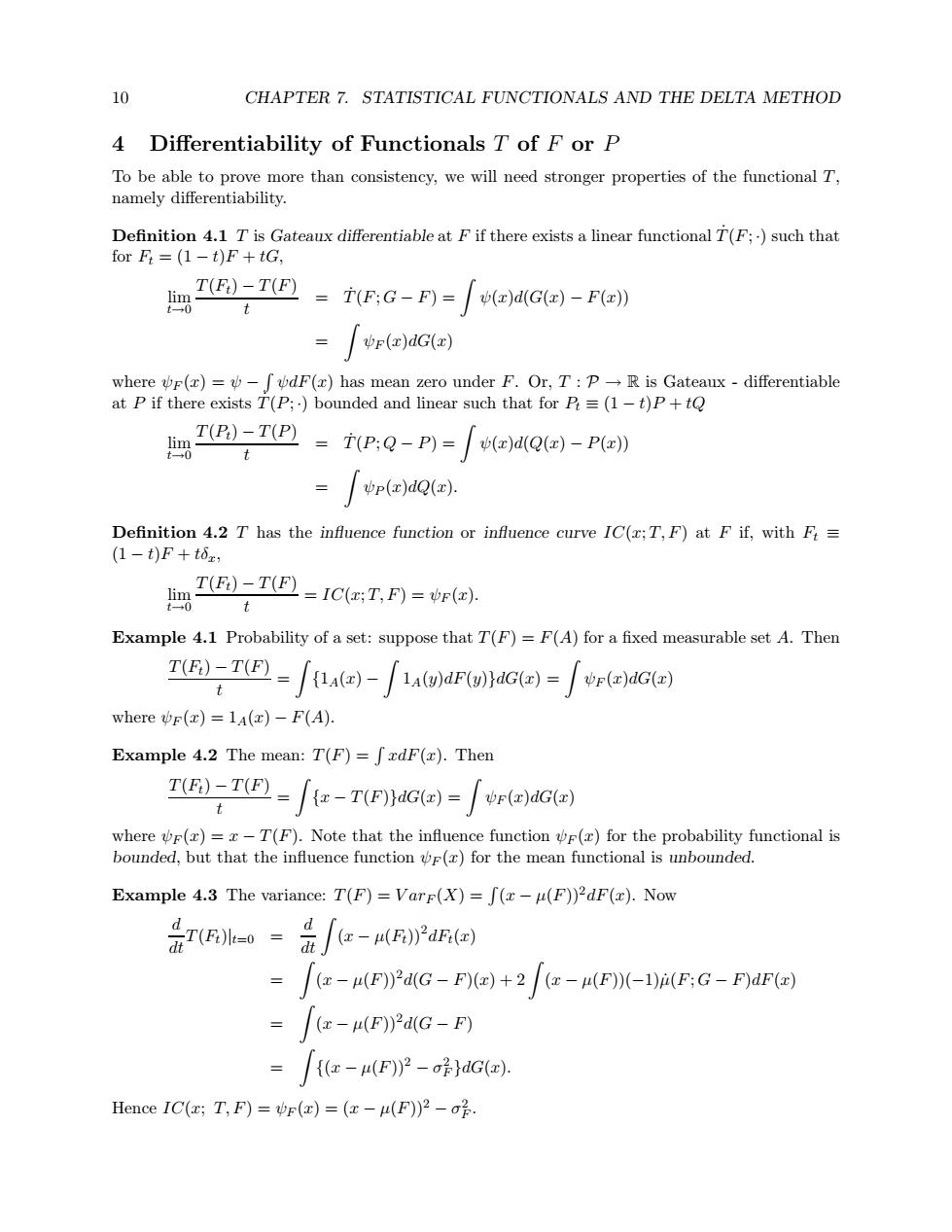正在加载图片...

10 CHAPTER 7.STATISTICAL FUNCTIONALS AND THE DELTA METHOD 4 Differentiability of Functionals T of F or P To be able to prove more than consistency,we will need stronger properties of the functional T, namely differentiability. Definition 4.1 T is Gateaux differentiable at F if there exists a linear functional T(F;)such that for F=(1-t)F+tG, T(F)-T(F) lim (x)d(G(x)-F(x)) t→0 t =T(F;G-F)= Vr(x)dG(x) where vr(z)=-fodF(r)has mean zero under F.Or,T:P-R is Gateaux-differentiable at P if there exists T(P;)bounded and linear such that for P=(1-t)P+tQ T(P)-T(P) i(P:Q-P)= (x)d(Q(x)-P(x)) t vp(x)dQ(x). Definition 4.2 T has the influence function or influence curve IC(x;T,F)at F if,with F= (1-t)F+tδx, 0 T(Ft)-T(F)=IC(:T,F)=vF(). Example 4.1 Probability of a set:suppose that T(F)=F(A)for a fixed measurable set A.Then T(F)-T(F) 2-A回)-∫1 x(u)dF(wydG(z)= VF(x)dG(x) t where vr(x)=1A(x)-F(A). Example 4.2 The mean:T(F)=fxdF(x).Then TE)-TE-∫e-TPaG)= VF(x)dG(x) t where vr(x)=x-T(F).Note that the influence function vr(x)for the probability functional is bounded,but that the influence function vr(x)for the mean functional is unbounded. Example 4.3 The variance:T(F)=Varr(X)=f(x-u(F))2dF(x).Now 品ro=品∫e-MPaa =/(-u(F)2dG-F()+2(e-(F(-1)a(F;G-F)dF) (x-μ(F)2d(G-F) ={(x-u(F)2-o2}dG(x). Hence IC(z;T,F)=vF(z)=(-u(F))2-10 CHAPTER 7. STATISTICAL FUNCTIONALS AND THE DELTA METHOD 4 Differentiability of Functionals T of F or P To be able to prove more than consistency, we will need stronger properties of the functional T, namely differentiability. Definition 4.1 T is Gateaux differentiable at F if there exists a linear functional T˙(F; ·) such that for Ft = (1 − t)F + tG, lim t→0 T(Ft) − T(F) t = T˙(F; G − F) = # ψ(x)d(G(x) − F(x)) = # ψF (x)dG(x) where ψF (x) = ψ − " ψdF(x) has mean zero under F. Or, T : P → R is Gateaux - differentiable at P if there exists T˙(P; ·) bounded and linear such that for Pt ≡ (1 − t)P + tQ lim t→0 T(Pt) − T(P) t = T˙(P; Q − P) = # ψ(x)d(Q(x) − P(x)) = # ψP (x)dQ(x). Definition 4.2 T has the influence function or influence curve IC(x; T, F) at F if, with Ft ≡ (1 − t)F + tδx, lim t→0 T(Ft) − T(F) t = IC(x; T, F) = ψF (x). Example 4.1 Probability of a set: suppose that T(F) = F(A) for a fixed measurable set A. Then T(Ft) − T(F) t = # {1A(x) − # 1A(y)dF(y)}dG(x) = # ψF (x)dG(x) where ψF (x)=1A(x) − F(A). Example 4.2 The mean: T(F) = " xdF(x). Then T(Ft) − T(F) t = # {x − T(F)}dG(x) = # ψF (x)dG(x) where ψF (x) = x − T(F). Note that the influence function ψF (x) for the probability functional is bounded, but that the influence function ψF (x) for the mean functional is unbounded. Example 4.3 The variance: T(F) = V arF (X) = " (x − µ(F))2dF(x). Now d dtT(Ft)|t=0 = d dt # (x − µ(Ft))2dFt(x) = # (x − µ(F))2d(G − F)(x)+2 # (x − µ(F))(−1) ˙µ(F; G − F)dF(x) = # (x − µ(F))2d(G − F) = # {(x − µ(F))2 − σ2 F }dG(x). Hence IC(x; T, F) = ψF (x)=(x − µ(F))2 − σ2 F